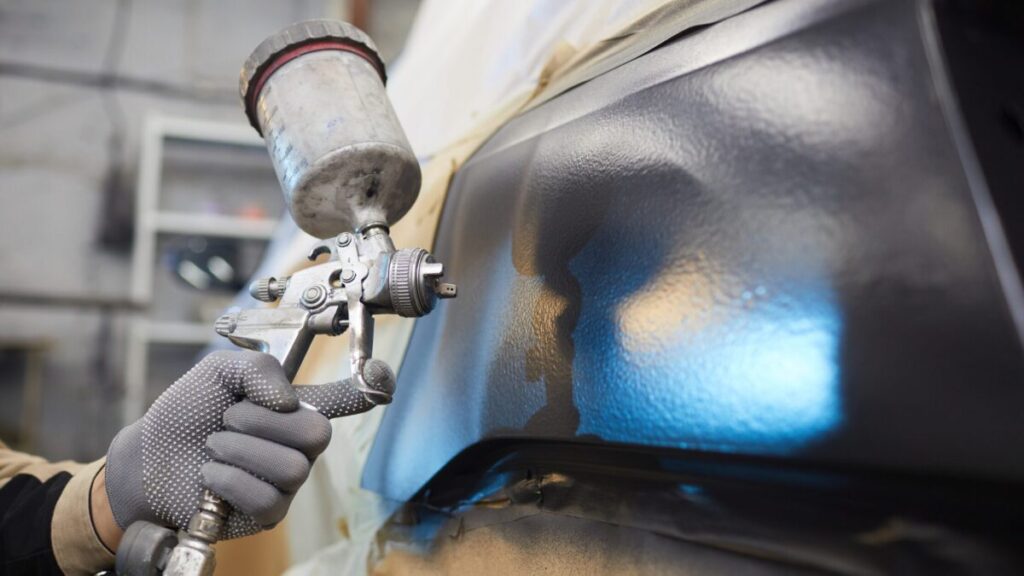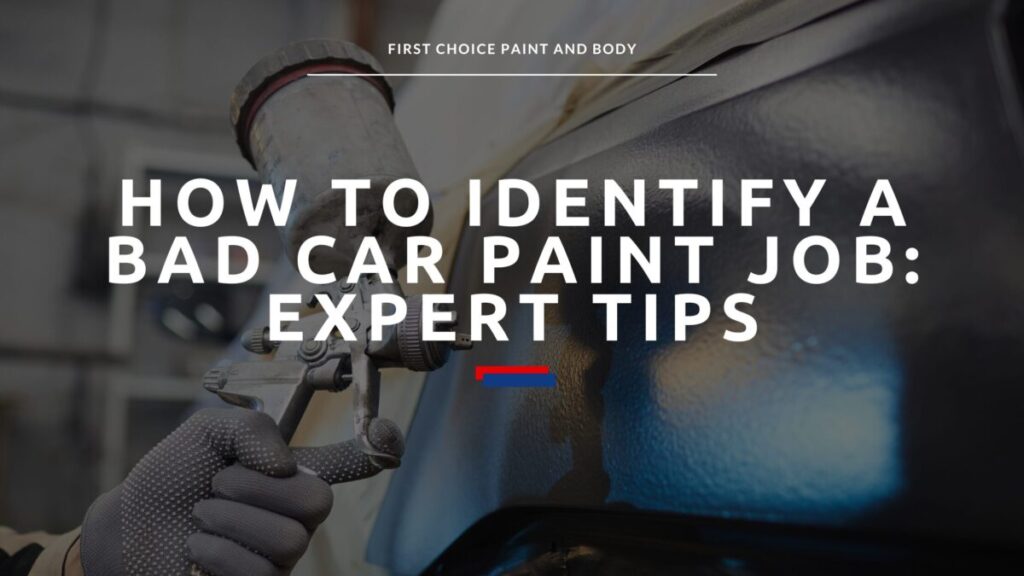How to Identify a Bad Auto Body Paint Job

A car’s paint job significantly impacts its overall appearance, value, and protection against the elements. However, not all paint jobs are created equal. A bad car paint job can leave your vehicle looking worse than before, diminishing its value and even leading to costly repairs. In this article, we’ll provide expert tips on how to identify a bad car paint job, helping you ensure your vehicle gets the quality finish it deserves.

Importance of a Quality Car Paint Job
A high-quality car paint job is crucial for several reasons, each playing a significant role in maintaining your vehicle’s overall value and longevity.
Aesthetics
Firstly, aesthetics are a major factor. A smooth, glossy paint job enhances your car’s appearance, making it look well-maintained and attractive. The visual appeal of a car can be greatly diminished by a poor paint job, which can make even a new car look older and neglected. On the other hand, a professionally done paint job can restore the car’s original beauty, giving it a fresh, appealing look that can turn heads on the road.
Imagine driving a car with a patchy, uneven paint job – it not only looks unappealing but also suggests neglect and poor maintenance. Conversely, a car with a pristine paint job communicates that it is well-cared for, potentially leading to more positive social interactions and personal satisfaction for the owner.
Resale Value
Secondly, the quality of your car’s paint job has a direct impact on its resale value. A well-painted car can fetch a higher resale price, as potential buyers are often willing to pay more for a vehicle that looks pristine and well-cared-for. Conversely, a poorly painted car can deter potential buyers, leading them to question the overall maintenance and care of the vehicle.
The first impression a buyer gets from the car’s exterior can significantly influence their purchasing decision. For instance, if a buyer sees a car with faded or peeling paint, they may assume the vehicle has been neglected in other areas as well. This can lead to lower offers or difficulty selling the car altogether.
Auto Body Protection
Lastly, a quality paint job provides essential protection for your car’s body. Quality paint protects your car’s body from rust, corrosion, and environmental damage. The paint acts as a barrier against moisture, road salts, UV rays, and other harmful elements that can cause the metal body to deteriorate over time. Without this protective layer, the car’s body is more susceptible to damage, which can lead to costly repairs.
A good paint job not only keeps your car looking good but also extends its lifespan by protecting it from the elements.
For example, exposure to the sun can cause paint to fade and oxidize, while road salt can lead to rust and corrosion, especially in colder climates. A high-quality paint job helps mitigate these risks, preserving the structural integrity of your car.
Common Signs of a Bad Car Paint Job
Identifying a bad car paint job involves looking for specific defects. Here are some common signs to watch out for:
Uneven Color and Texture: A quality paint job should have a uniform color and texture. Variations in color or a patchy finish are clear indicators of a poor paint job.
Visible Dust and Debris in the Paint: Tiny particles trapped in the paint can create a rough surface. These imperfections often result from painting in an unclean environment.
Poor Masking and Overspray: Look for paint on areas that shouldn’t be painted, such as windows, trim, and tires. This indicates careless masking and overspray.
Drips and Sags: Paint drips and sags are usually caused by applying too much paint at once. These defects create an uneven surface and are a telltale sign of amateur work.
Orange Peel Effect: This refers to a texture that resembles the surface of an orange peel. It occurs when the paint doesn’t spread evenly, often due to incorrect application techniques.
Color Mismatch: If the newly painted areas don’t match the original color, it’s a sign of poor color mixing or matching.
Bubbles and Blisters: These occur when air or moisture gets trapped under the paint, leading to bubbles or blisters that eventually cause the paint to peel.
Lack of Shine or Gloss: A dull finish indicates insufficient polishing or improper application of the clear coat.
Expert Tips for Inspecting a Car Paint Job
Ensuring a high-quality paint job for your car involves a meticulous inspection process. Start by examining the paint in good lighting conditions. Natural light is ideal for revealing paint defects, so if possible, inspect the car outdoors on a sunny day. Harsh or uneven lighting can hide imperfections, making it difficult to accurately assess the paint’s quality. Look for any inconsistencies in color, texture, and shine that might indicate a poor-quality paint job.
Next, feel the surface for smoothness. Run your hand over the painted surface to detect any rough patches, bumps, or grit. A quality paint job should have a silky, smooth finish. If you notice any rough texture, it could indicate that dust or debris was trapped in the paint, often due to painting in an unclean environment or insufficient surface preparation before painting.
Pay close attention to the edges and corners of the car’s panels. These areas can be challenging to paint, and inconsistencies often occur here. The paint should be as smooth and uniform in these areas as it is on the larger panels. Look for any signs of overspray, drips, or thin paint coverage, which can indicate a lack of attention to detail.
Examine different panels to ensure the color and texture are consistent throughout the car. Variations in color or a patchy finish are clear indicators of a poor paint job. The paint should have an even distribution without any noticeable differences between panels. A high-quality paint job will have a uniform appearance, indicating proper application and color matching.
One effective way to gauge the quality of a paint job is to look at reflections on the car’s surface. A high-quality paint job from auto body shop will produce clear, sharp reflections. Stand at different angles and observe how well the surface reflects objects around it. Blurry or distorted reflections can indicate surface imperfections such as the orange peel effect, where the paint texture resembles the skin of an orange.
If possible, compare your car’s paint job with other cars, especially those freshly painted by a reputable paint shop. This comparison can provide a benchmark for evaluating your paint job’s quality. Look for differences in shine, smoothness, and overall finish. A side-by-side comparison can help you spot defects that might not be as noticeable when viewing your car alone.
Be on the lookout for common defects such as drips, sags, and the orange peel effect. Drips and sags usually result from applying too much paint at once, creating an uneven surface. The orange peel effect occurs when the paint doesn’t spread evenly, resulting in a texture that resembles the surface of an orange peel. These defects indicate amateur work and can significantly detract from the appearance of your car.
Ensure that areas not meant to be painted, such as windows, trim, and tires, are free from paint. Poor masking can lead to overspray, where paint ends up on areas it shouldn’t be. This indicates carelessness and a lack of professionalism. Proper masking is essential for a clean, precise paint job, so check these details carefully.
Finally, evaluate the overall finish for its shine and gloss. A dull finish indicates insufficient polishing or improper application of the clear coat. A high-quality paint job should have a deep, glossy shine that enhances the car’s appearance. If the paint looks flat or lacks luster, it may not have been polished correctly or the clear coat may not have been applied properly.
By following these expert tips, you can thoroughly inspect a car paint job and ensure it meets high standards of quality. Investing time in a careful inspection can save you from potential disappointments and costly repairs, ensuring your car looks its best and maintains its value.
Back to top: How to Identify a Bad Car Paint Job
